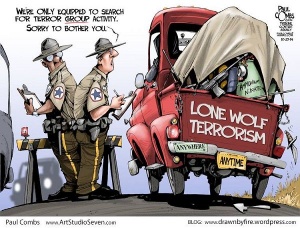
Lone Wolf Terror
Europe, the US, and the Middle East exist in a moment of unprecedented global tension. In the face of collapsing, budding, and rapidly changing alliances, they share one common enemy: lone-wolf terrorists.
Lone-wolf terrorists are those who operate on their own, without the constraints imposed by an organisation with a structured hierarchy and chain of command. They are “self-radicalized individuals who commit violent acts to promote a cause or support a belief system… they appear to be isolated and avoid many of the traditional organizational characteristics used to identify and track traditional terrorist groups”. They pose an increasing threat to the United States and much of Europe, where most terrorist groups lack a structured presence but still possess the ability to radicalise individual members of society through media and the Internet. Though they may not be “official” members of any terrorist organisations, they often draw their inspiration from such groups, mimicking their tactics and claiming them as inspiration for the attacks.
Because they are isolated individuals, lone-wolf terrorists often lack access to the weapons, funding, and infrastructure possessed by larger terrorist groups. Instead, they use whatever they can find- knives, guns, homemade bombs- to orchestrate small-scale attacks which incite large-scale panic. As explained by Rodger Bates of Clayton State University, “the power of the lone wolf terrorist is not necessarily the actual level of harm potentially experienced, but the level of intimidation that the threat of such random acts of violence can exert on a community”- and that’s exactly what their intention is. Lone-wolf tactics are so effective that ISIS and others have directly encouraged followers worldwide to “pick up a knife, gun or any weapon and become personal warriors for the cause,” shrouding potential victims worldwide in a blanket of constant worry.
A critical factor in creating the large-scale panic these terrorists desire is the media. By focusing in extreme detail on attacks which only affect a small number of people, reporters unwittingly magnify the threat and introduce widespread panic into the public psyche. Knowing that civilians in the Western world are living in constant, subconscious worry of an attack is exactly what radical groups desire, and thus intense media coverage plays right into their hands.
Perhaps even more dangerously, extensive coverage of lone-wolf attacks may encourage more individuals to propagate attacks in the future. Individuals disenfranchised from society, particularly isolated young men, witness how much fame and notoriety lone-wolf attackers receive in the wake of the attack. This encourages them to follow the lead of those who have gone before them, creating a knock-on effect which exponentially increases the threat of terrorism in the long run.
In their quest to prevent these attacks from happening, the challenge to law enforcement lies in their apparent randomness. Because lone-wolf terrorists have few concrete ties to extremist organisations, it is very difficult to preemptively track them down and predict when the attacks will occur. Instead of placing their main focus on individuals who may be radicalised, it may therefore be more productive for law enforcement to target the factor which is most rapidly radicalising them: the media.
In this case, “the media” encompasses a variety of sources. It is important to note that, because lone wolves have little direct access to members of terrorist organisations, most of their radicalisation occurs digitally. This happens through message boards, radicalising videos, and even traditional forms of social media such as Twitter. Policing these more heavily will efficiently cut off a major terrorist recruitment tool, decreasing their reach, exposure, and membership in the long run. Most private social media companies, such as Facebook and Twitter, have stringent rules of use which ban any content encouraging terrorism or violence, but they rely upon a relatively small team of moderators to enforce this, who mainly respond to reports they receive from members and rely upon self-policing among the social media community. Perhaps establishing federal legislation requiring that each social media outlet establishes a team of moderators proportionate to the size of their user body would solve some of this problem, and ensure that posts by radicalising users are more quickly taken down.
But social media is not the only issue, and traditional media exposure is a huge issue as well. As I outlined earlier, extensive media coverage and the 24-hour news cycle can embolden those who view it to join the terrorist organisations being reported on, so networks would be wise to reduce the extensive profiles they often do of lone-wolf terrorists and perhaps even avoid mentioning them by name. As individuals, we can refrain from sharing or clicking on articles about such people, reducing their reach and the chances that their actions could inspire other disillusioned individuals to radicalise in the future.

http://editorialcartoonists.com/cartoon/display.cfm/136866/
